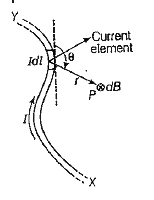Biot-Savart.s Law This law deals with the magnetic field induction at a point due to a small current element (a part of any conductor, carrying current). Let XY be current carrying conductor, I be current in the conductor, dl be infinitesimal small element of the conductor, let dB be magnetic field at point P at a distance r from the element. According to Biot-Savart.s law, the magnitude of magnetic field induction (dB) at a point P due to a current element depends on the following factors:
(i) `dB prop l` (i.e. magnetic field is directly proportional to the current flowing through the conductor). (ii) `dB prop dl` (i.e. magnetic field is directly proportional to the length of the element). (iii) `dB prop sin theta` (i.e. magnetic field is directly proportional to the sine of angle between the length of element and line joining the element to point (P). (iv) `dB prop (1)/(r^2)` (i.e. magnetic field is inversely proportional to the square of distance between the element and point P). Combining all the above relations,
`dB prop (Idl sin sin theta)/(r^2)`
This relation is called Biot-Savart.s law.

In vector form, Biot-Savart.s law can be written as
`dB prop (Idl xx r)/(r^3) = (mu_0)/(4pi). (Idl xx r)/(r^3)`
